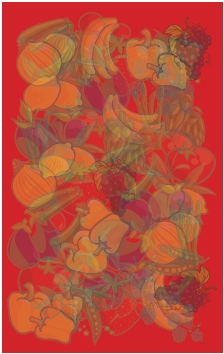
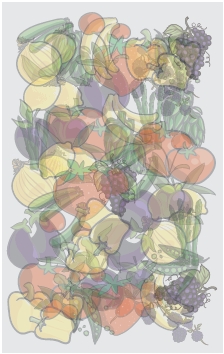
 Divide the deck according to the color of the back of the cards: Red (16), White (32) and Green (40).
Divide the deck according to the color of the back of the cards: Red (16), White (32) and Green (40).
Remember that in the box there are two extra Joker cards. One is for the game in 5 players, the other is used as a spare emergency card.
The dealer will distribute the cards to each player this way:
- 4 Red cards: uncovered, and these cards will remain accessible and visible to all
- 8 White cards: covered, but each player can pick them up and look them
- 6 Green cards: covered, the players can’t look at them until the right conditions are created: this bunch of cards is called "the well".
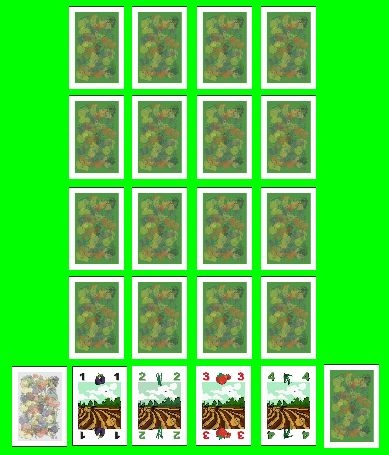
The 16 remaining cards are placed on the table, covered, in a grid of 4 x 4 on the center table called "the field".
At this point you should find yourself in a situation similar to that of the figure showed to the right, where you also see the cards of one of the players: the four "lands". The 8 White cards ready to be picked up, and the remaining six Green cards.
Everything is ready: The player who owns the Eggplant “Farmland” card, which has a black number “1”, starts.
The game continues clockwise until one of the players doesn’t finish his turn, and as such, finishes all the cards that he has.
On his turn a player can play all the cards he/she wants. When you want to end your game please notify the opponent on the left saying "I’m done".
WARNING: playing at least a card or a joker (the "Tractor") is required. If a player is in the condition of not being able to play, apply the consequences that you can read in the article "What happens when you pass".
The "Farmland" cards (those numbered 1 to 4,that each player has, uncovered, before him) have to be handled a little bit differently from all the others: when they come into play they should be placed on the 4x4 grid in substitution of one of the Green cards.
The replaced card comes into possession of the player, who can look at it and, if he desires, and the conditions are right, play it.
All other types of cards, instead, have to be put above the "Farmland", to build a sequence that must meet these conditions:
- same color as the numeric series (you can’t put a Green card on a Black one)
- numerical increase of 4 in 4 (helped also by the type of fruit / vegetable on the cards)
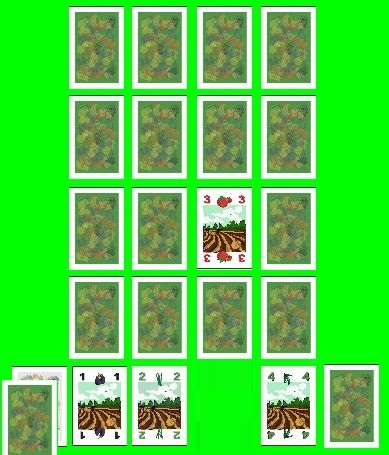 A brief chart example will help understand everything .
A brief chart example will help understand everything .
Here we see the players’ choice and we describe the effects.
The 3rd Red "strawberry Farmland", forces all players to place the Red vegetables family on this row.
But not only: this move "imposes" all the columns of the Field.
All the 1 "Farmland" cards will be moved leftmost, the 2 between 1 and 3 and 4 in the bottom right..
Above the 3rd Red will follow orderly: 7 followed by the 11th card, then the 15th and finally the 19th, which closes the sequence.
Could’ve the player choose a different line? Yes. To its complete discretion.
Could player choose a different column? Theoretically yes, wanting to complicate the game you could position the "Farmland" cards at will, but this choice, in fact, would not give any real advantage, or more strategic depth. Better to assume that every coloured family has its own line of reference and, in this line, the cards are in order from 1 to 4.
During his turn, if a player can show that he has less than six cards in his hand, he has to pick up the well, the bunch of green backed cards that were delivered by the dealer after shuffle.
But remember: first you must to play (minimum) one card!
Collecting the well has two main effects:
- The turn passes immediately to the next player, there’s no need of any sign of consent.
- The player earns 10 points for each player who already hasn’t picked up its’ well yet, so 30 points will be given to the first, 20 to the second and 10 to the third. The last player who picks up the well doesn’t receive any points at all.
As more fully explained in the next chapter, the well shall be collected even if you run out of cards because of a "Pass".
The joker card, the "Tractor" one, has two possible uses. 
During your turn, you may discard it and this allows you to continue the game on your left without playing any other cards.
It’s a very useful defensive action to avoid passing, but it is also an important strategic choice, if we can use it to delay the release of a valuable card for our opponents.
The other use is to replace any card numbered 1 through 16 (therefore excludes all final fruits / vegetables), but in order to play this type of move is also essential to position the immediately following card of the sequence .
If you do not have such card, the joker cannot be played.
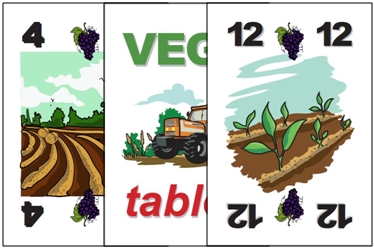 It is possible to use more than one joker in the same sequence
It is possible to use more than one joker in the same sequence
In the example on the left you see how the player who needed the black 8 card has played the "Tractor" followed by 12.
The player whose card has been replaced may discard it at any time, but the effects of this move become active only when it’s the players’ effective turn.
Each time you complete a sequence, playing one of the fruit/vegetable cards (17 to 20) you will earn 10 (ten) points.
If, closing the sequence, you also complete the color family, you shall add another 30 points.
In addition, you may gain points with the collection of your well, when, during your turn, you prove to have less than 6 (six) cards in hand.
10 points will be assigned for each player who still has to pick up the well, as such, we will have 30 points to the first, 20 points to the second and 10 to the third. The last player to collect the well does not gain points.
Lastly, there are closure points. When the player finishes all the cards that he has been assigned, the player receives 10 points for each sequence still not closed.
Remember to claim the score update every time you earn points.
Here is a trap to avoid. Or where you may drop your opponents in, depending on your style of play.
As we read in the previous chapters, during your turn you may play as many cards as you want, but you must play at least one.
It can happen, though, that you may find yourself in the condition of having no playable cards, as such you have to declare a "Pass". This actions have different types of consequences.
The rule is: every time you "pass" you pay 50 points, unless you have cards in hand to uncover on your table.
This means that the first time you are in a position to "pass", you will not pay the 50 points, but instead you will discover on the table all the cards in your hand and, from that moment on, play with uncovered cards.
At that point, because you have less than six cards in hand, you have to collect the well, give yourself any points and your turn is over.
In the unfortunate case (but by no means unlikely, heavily depending on your opponents), which later you are still in the condition of not having playable cards, instead of paying the 50 points, again you will show all the cards in your hand (those of well you just picked up), while continuing to play with uncovered cards.
But from this point on, if you were to "pass", you will not have shortcuts: each time 50 points will be subtracted from your score.
Keep in mind that the consequences of “passing” are not a choice: if you have cards that can be played, you have to do so.